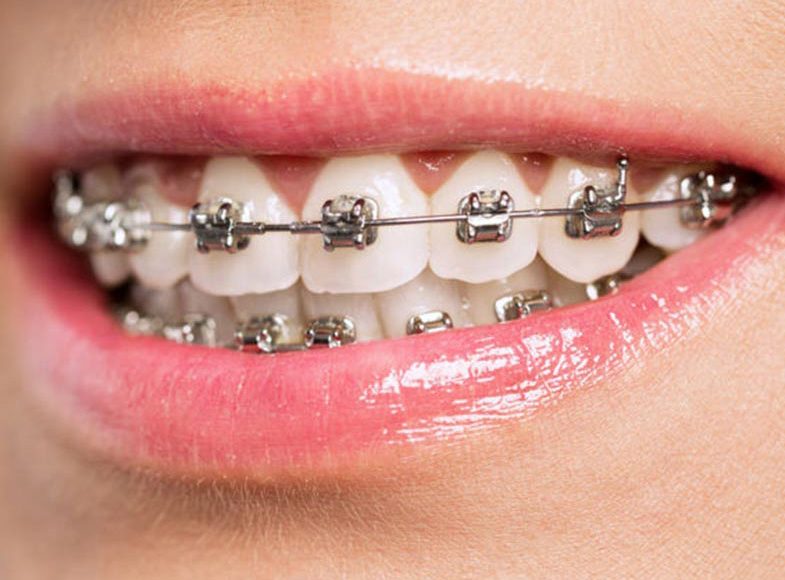post, we will explore six possible options for teeth straightening that can help boost your confidence and give you a picture-perfect smile. So let’s dive in and discover which option is best for you!
- Traditional Braces
Traditional braces are the most common teeth straightening option available. They consist of metal brackets attached to each tooth. They are connected with wires and rubber bands. These work to apply pressure to gradually shift the teeth into their desired position.
While traditional braces may not be the most aesthetically pleasing option, they are effective for correcting complex dental issues. This includes severe overcrowding or bite problems. Plus, they can achieve results faster than some other options.
One downside of traditional braces is that they require frequent adjustments by an orthodontist. It is usually required every 4-6 weeks. This can be inconvenient and time-consuming. Patients may also experience discomfort or soreness after each adjustment.
- Ceramic Braces
Ceramic braces are a discreet teeth straightening option that many people choose to undergo. These braces function similarly to traditional metal braces.
But, instead of being made from metal wires and brackets, they are constructed using tooth-colored materials. Because of this, they are less noticeable than their metallic counterparts.
Ceramic braces have some unique advantages over other options like lingual or self-ligating braces. Because the material used is more comfortable than metal, patients experience less discomfort while wearing ceramic braces. Additionally, the design allows for easier cleaning. This is when compared to traditional wire-and-bracket systems.
However, there are some drawbacks to consider before choosing this type of brace system. Ceramic brackets may be weaker and can break more easily. This is also when compared to their metal counterparts due to their composition.
Ceramic braces also require close attention when it comes to oral hygiene. This is because the brackets can become stained if not cleaned properly.
- Lingual Braces
Lingual braces are similar to traditional metal braces but with one crucial difference. They are fitted behind the teeth instead of on the front. This makes them a great option for people who don’t want to undergo orthodontic treatment.
The process of getting lingual braces is more complex. It requires a highly skilled orthodontist. This is because of the placement of the brackets and wires on the back of the teeth. Because of this, lingual braces tend to be more expensive than other types of braces.
Some users may find that it takes longer for their mouths to adjust to wearing lingual braces. This is because they can affect speech patterns temporarily. However, once patients get used to them, they become comfortable and invisible.
Lingual braces require proper care just like any other type of brace. Users should brush twice daily with fluoride toothpaste and floss regularly between each bracket. These should be done while being careful not to damage or dislodge any wires or brackets during cleaning sessions.
- Invisalign
Invisalign has become a popular alternative to traditional braces. This is because of its discreet appearance and convenience. These clear, plastic aligners are custom-made for each patient. This allows for a comfortable fit that gradually shifts teeth into their desired position.
One of the biggest advantages of Invisalign is its nearly invisible appearance. Invisalign aligners are virtually undetectable when worn. This makes them a popular choice among adults who may feel self-conscious about wearing traditional braces in professional or social settings.
Another benefit of Invisalign is the ability to remove the aligners during meals and while brushing and flossing your teeth. This means there are no dietary restrictions. There are also no challenges with oral hygiene as there can be with traditional braces.
However, it’s important to note that not everyone is a candidate for Invisalign treatment. Patients with more complex orthodontic needs may require traditional braces or other types of treatment. It’s best to consult with an orthodontist to determine which option will work best for you.
- Self-Ligating Braces
Self-ligating braces use a special clip or bracket to hold the wire in place. This eliminates the need for elastic bands. One of the biggest advantages of self-ligating braces is that they require fewer adjustments than traditional braces. This means fewer appointments with your orthodontist.
Another benefit is that self-ligating braces can often produce faster results compared to other options. The lack of elastic bands allows for more efficient tooth movement. This can shorten treatment times.
Self-ligating braces also tend to be more comfortable than traditional metal braces. This is because they apply less pressure on your teeth. Additionally, since there are no rubber bands involved, you won’t have to deal with any unsightly staining or discoloration.
- Accelerated Orthodontics
Accelerated orthodontics is a relatively new option that offers faster results by using advanced technology to speed up the tooth movement process. It involves techniques such as AcceleDent® and Propel®. It stimulates bone remodeling and makes it easier for teeth to shift into their desired positions more quickly.
While this method may not be suitable for everyone, it’s an excellent choice for those who want to see results sooner rather than later. Of course, as with any dental procedure or treatment plan, it’s essential to consult with an experienced orthodontist before making any decisions about your oral health.
If you are interested in any of these, check out this Stride custom braces provider.
Consider These Possible Teeth Straightening Options
No matter what teeth straightening option you choose, always remember to consult your dentist first. Each option has its benefits and drawbacks, so it’s important to research and weigh your options properly before making a decision.
With so many options out there, it’s never been easier to achieve that perfect smile. So why not take the leap and start feeling confident in your healthy smile today?
Explore our blog for more helpful facts.



